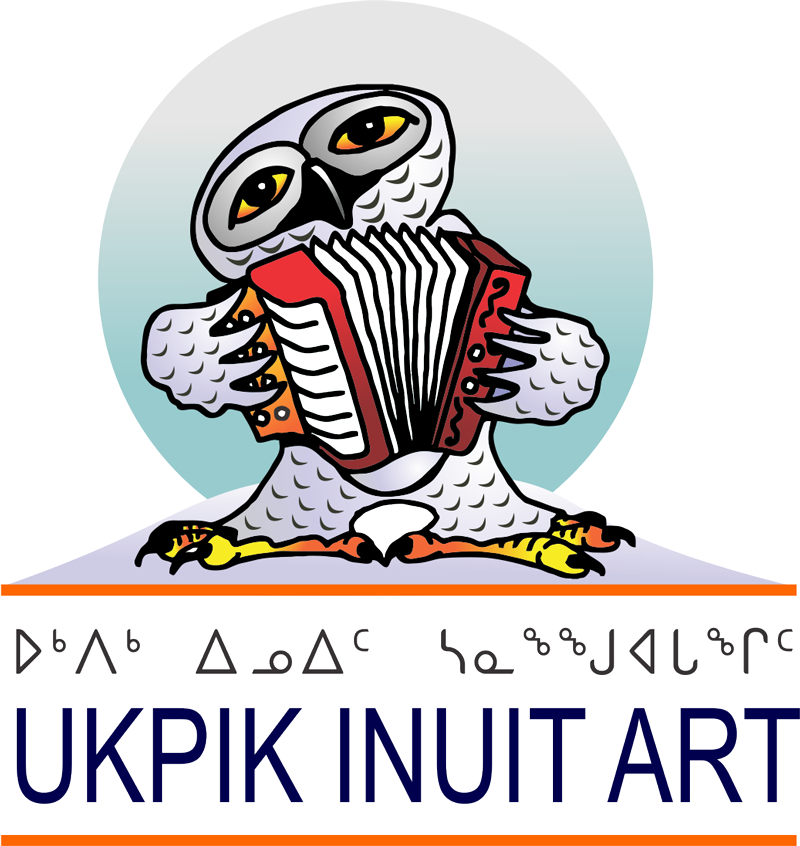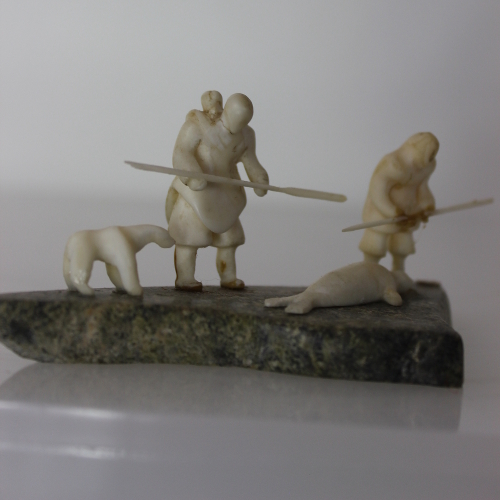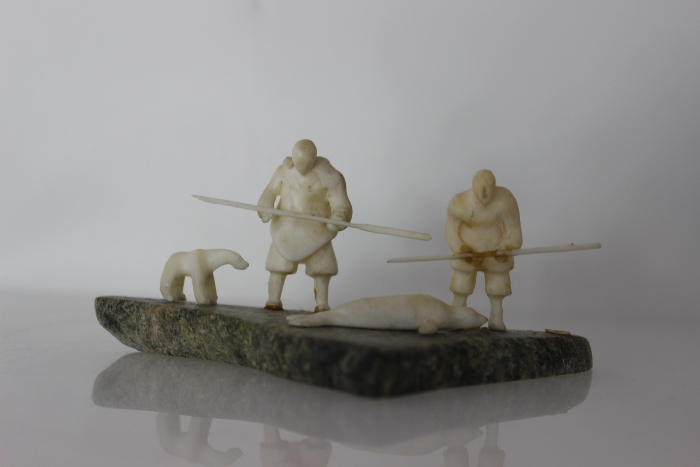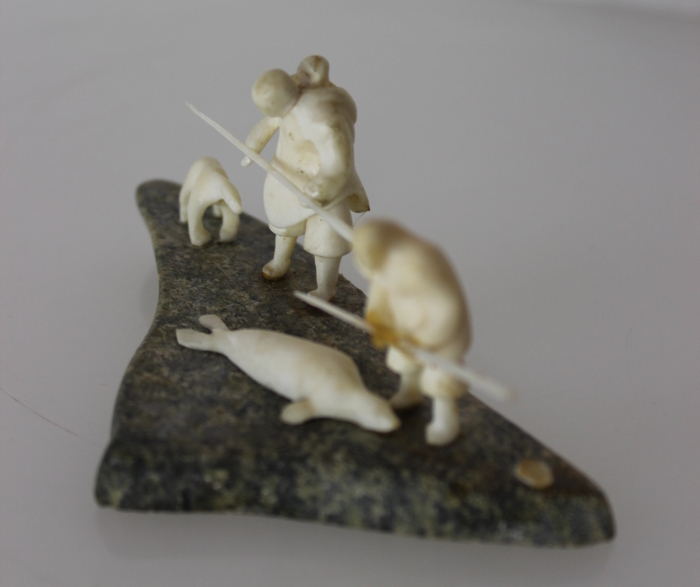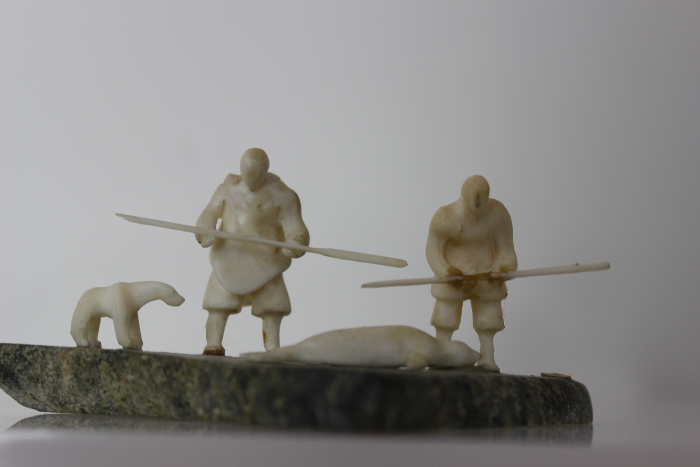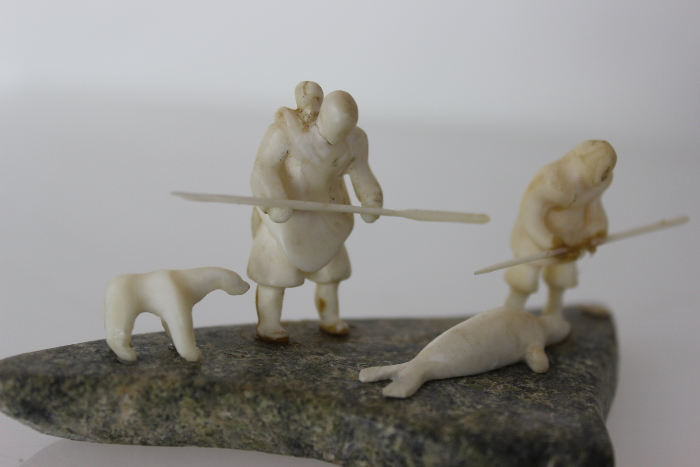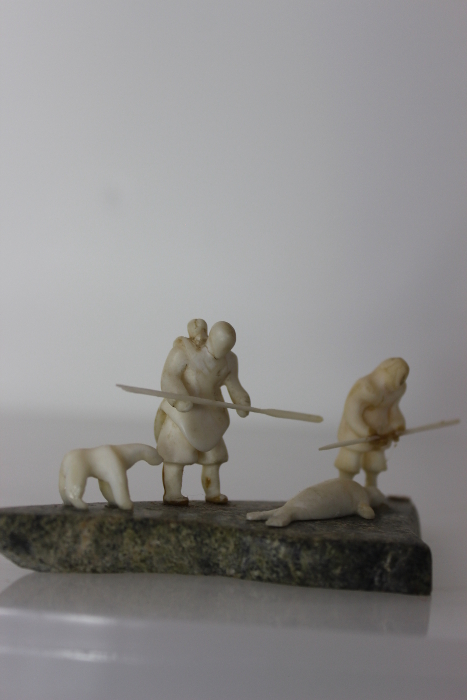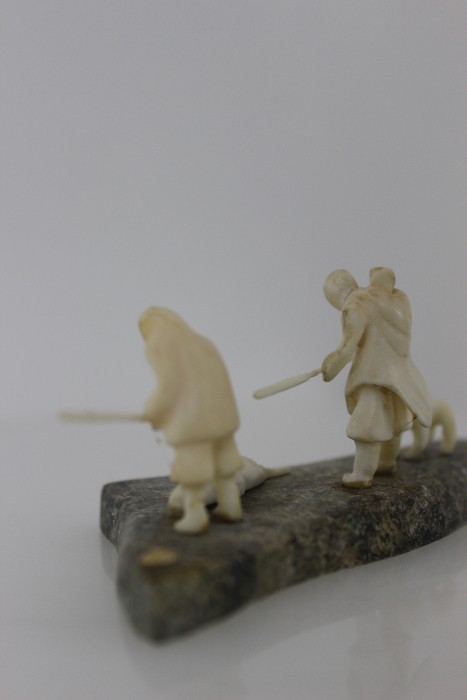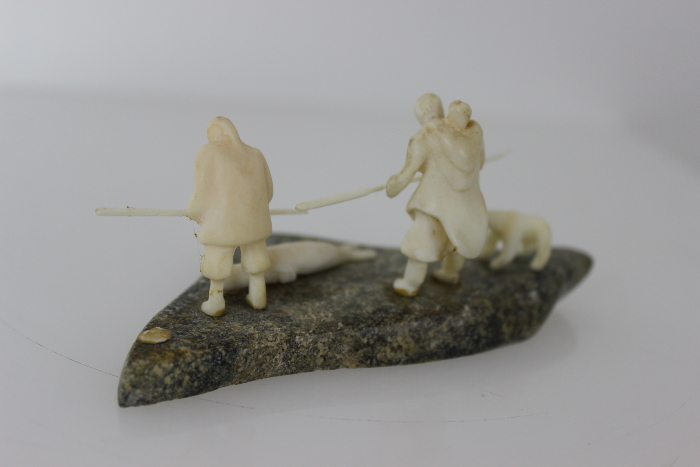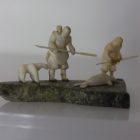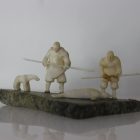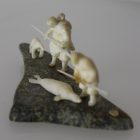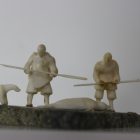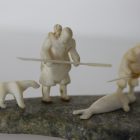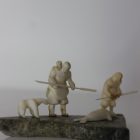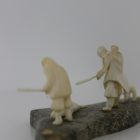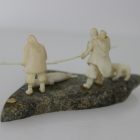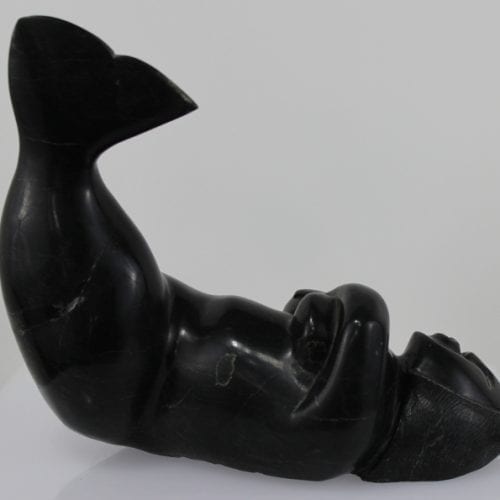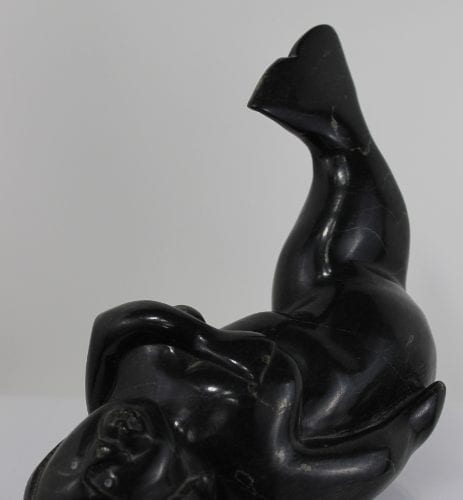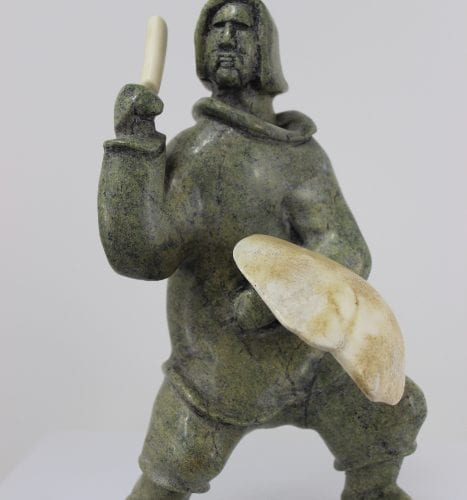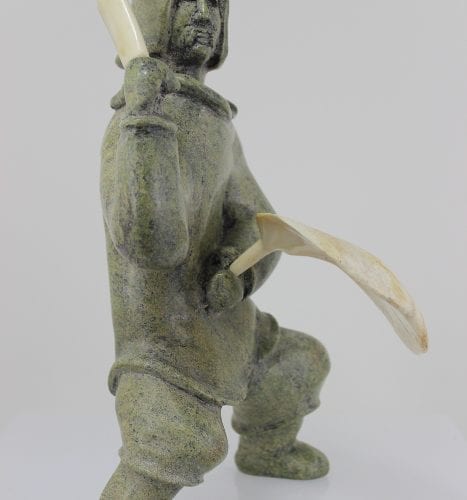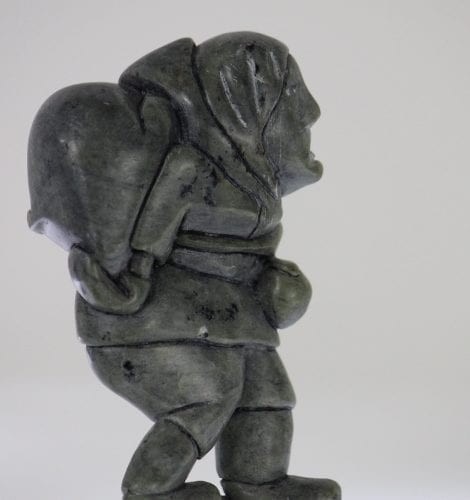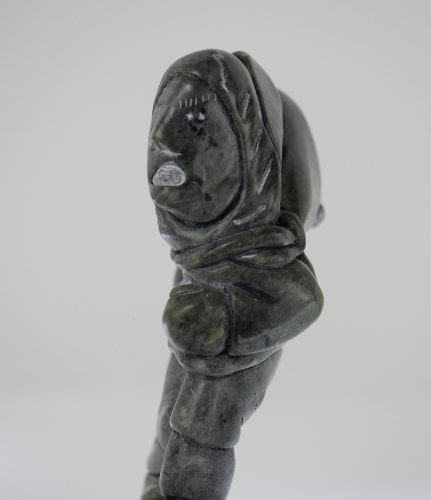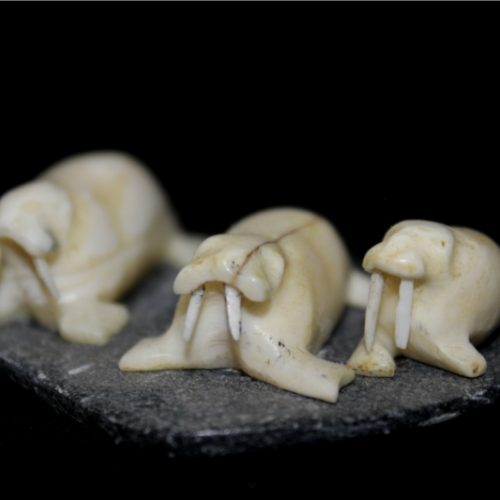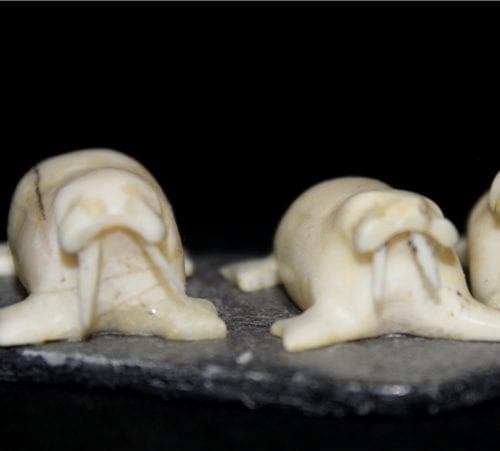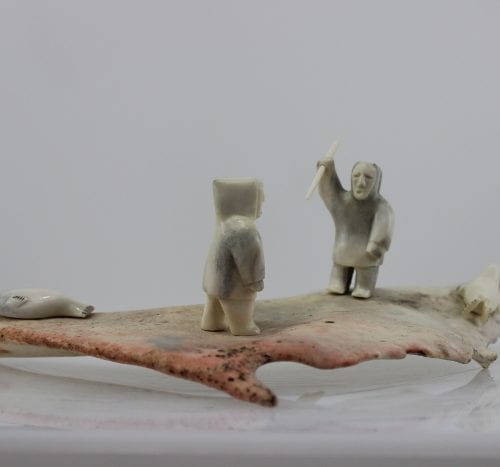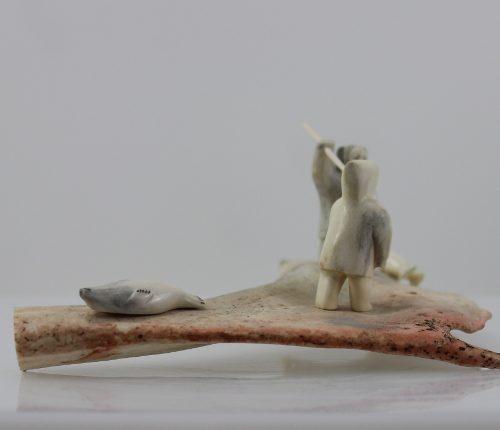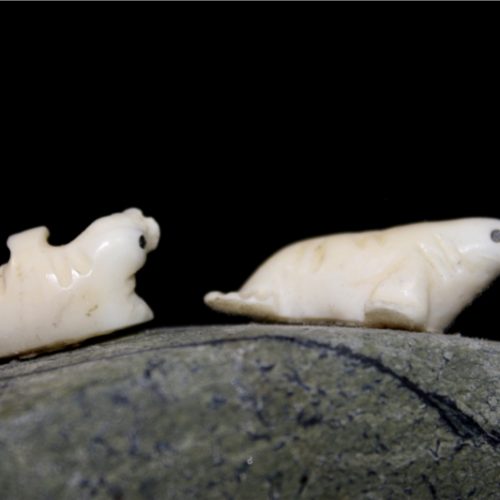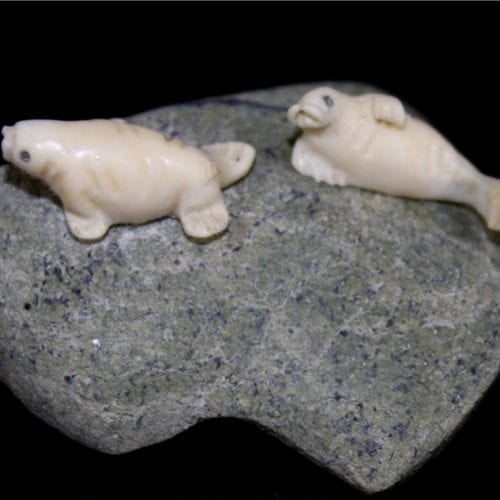Biography Mark Tungilik from the Archives of askART
Biography from the Archives of askART
Mark Tungilik (1913 – 1986)
Mark Tungilik was born in the Kitikmeot region of what is now Nunavut, Canada and died in Repulse Bay, Nunavut, where he had lived since about 1948. His carvings have been included in many landmark exhibitions, his life is discussed in virtually every comprehensive Inuit Art history book, and his works are in the permanent collections of several major museums such as the National Gallery of Canada (Ottawa), the Canadian Museum of Civilization (Gatineau, Quebec) and The Metropolitan Museum of Art (New York). (1)(2)(3)
Tungilik was famous for his mixed medium ‘micro miniature’ marine ivory (walrus tusk or whale teeth) carvings composed with additional things like stone, whalebone*, baleen and sinew. These were frequently arranged in tableaus depicting Christian images (e.g. Christ, Priests and Angels); traditional Inuit spiritual images (e.g. shamans and transformation); syncretistic images (combining religious beliefs); Inuit genre (e.g. hunting, fishing, dog teams, ceremonies and family); legend; mythology; and arctic animals (e.g. musk-ox, bear, caribou, seal and birds).
His style could be described as Inuit Art*, Primitive Art* or Folk Art*. AskART images have some excellent illustrations of his work. Please note the sizes of some of the figures in works such as Hunters with Trapped Polar Bear, Arctic Animals on Base, Hunter Attacking Bear, Two Men and a Duck and the microscopic detailed figures on the lap tray of Seated Figure with Tableau.
As with most Inuit carvers of his era Tungilik was self taught; he began carving when he was a teenager (c.1930) to earn the cash needed to survive in an increasingly non-nomadic society. In 1939 Christian missionaries converted him to Catholicism and encouraged him to carve religious figures. One of which was presented to Pope Pius XII in 1948. However, Tungilik still continued to also carve animals as well as Inuit genre, secular, mythological and Inuit spiritual subjects. (4)
Tungilik’s works have been included in numerous important group exhibitions beginning with “Eskimo Art” which was one of the first Inuit* art shows at the National Gallery of Canada, Ottawa (1951). Subsequently, his carvings were included in exhibitions such as “Eskimo Carvings: Coronation [of Queen Elizabeth II] Exhibition”, Gimpel Fils, London, England (1953); “Eskimo Sculpture”, National Gallery of Canada, Ottawa (1955); “Eskimo Sculpture”, Winnipeg Art Gallery*, Manitoba (1967); “Sculpture of the Inuit: Masterworks of the Canadian Arctic”*, British Museum, London, et al. [see glossary] (1971); “Sculpture Inuit 25 Years After”, Canadian Guild of Crafts Quebec, Montreal (1973); “The Bessie Bulman Collection”, Winnipeg Art Gallery*, Manitoba (1973); “The Mulders’ Collection of Eskimo Sculpture”, Winnipeg Art Gallery, Manitoba (1976); “White Sculpture of the Inuit”, Simon Fraser Gallery, Simon Fraser University, Burnaby, B.C. (1977); “Repulse Bay”, Winnipeg Art Gallery*, Manitoba (1978); “Inuit Sculpture from the Collection of Mr. and Mrs. Eugene B. Power”, University of Michigan Museum of Art, Ann Arbor (1979); “The Abbott Collection of Inuit Art”, Winnipeg Art Gallery*, Manitoba (1980); “Inuit Masterworks”, McMichael Canadian Collection, Kleinberg, Ontario (1983); “Grasp Tight the Old Ways: Selections from the Klamer Family Collection of Inuit Art”, Art Gallery of Ontario, Toronto (1983 – 1985); “Uumajut: Animal Imagery in Inuit Art”, Winnipeg Art Gallery*, Manitoba (1985); “Aboriginal Rights in Canada”, National Library of Canada, Ottawa (1985); “Contemporary Inuit Art”, National Gallery of Canada, Ottawa (1986); “Selections from the John and Mary Robertson. Collection of Inuit Sculpture”, Agnes Etherington Art Centre, Kingston, Ontario (1986); “The Swinton Collection of Inuit Art”, Winnipeg Art Gallery, Manitoba (1987); “Winnipeg Collects: Inuit Art from Private Collections”, Winnipeg Art Gallery*, Manitoba (1987); “Selections from the John and Mary Robertson Collection of Inuit Art”, Agnes Etherington Art Centre, Kingston, Ontario (1988); “In the Shadow of the Sun: Contemporary Indian and Inuit Art in Canada”, Canadian Museum of Civilization, Gatineau, Quebec and touring (1988 – 1989); “The First Passionate Collector: The Ian Lindsay Collection of Inuit Art”, Winnipeg Art Gallery*, Manitoba (1990 – 1992); “Inuit Ivories from the Collection”, Winnipeg Art Gallery*, Manitoba (1992); “The Inuit Imagination”, Winnipeg Art Gallery*, Manitoba (1993); “Arctic Spirit: Inuit Art from the Albrecht Collection at the Heard Museum”, Heard Museum, Phoenix, Arizona (touring the USA 2006 – 2011); and in “Creation & Transformation: Defining Moments in Inuit Art”, Winnipeg Art Gallery, Manitoba (2013).
His works have also been included in solo and group exhibitions at prominent commercial galleries such as Marion Scott Gallery, Vancouver, B.C; Inuit Gallery of Vancouver, B.C.; Canadiana Galleries, Edmonton; Images Art Gallery, Toronto, Ontario; Snow Goose, Ottawa, Ontario; and Le Centre d’Art, Montreal.
As noted in the list of exhibitions above, Tungilik’s works are included in many important private collections; and, according to the Canadian Heritage Information Network* and individual museum websites, his works are also in many important public collections, such as the Art Gallery of Ontario (Toronto), Brooklyn Museum (Brooklyn, New York), Canadian Museum of Civilization (Gatineau, Quebec), Eskimo Museum (Churchill, Manitoba), Heard Museum (Phoenix, Arizona), Mackenzie Art Gallery (Regina, Saskatchewan), Museum of Anthropology (University of British Columbia, Vancouver), Museum of Inuit Art (Toronto, Ontario), Peabody Museum of Archaeology and Ethnology (Harvard University, Cambridge, Massachusetts), Portland Art Museum (Portland, Oregon), Prince of Wales Northern Heritage Centre (Yellowknife, Northwest Territories), The Metropolitan Museum of Art (New York City), Winnipeg Art Gallery* (Manitoba) and the National Gallery of Canada (Ottawa).
Footnotes:
(1) Researchers please note: Information for this biography was obtained from the listed sources using two different recognized first names for this artist – Mark and Marc. Two sources also note four additional names that may be used for this artist they are Tongelik Tungilik, Tongikik Tungilik, Tungalik Tungilik and Tangalik Tungilik. However, no other sources used in this biography referred to him by any of these names. Tungilik also has a Canadian government issued Inuit Disc Number* – E3320 – which may have been used to sign works and a signature in syllabics* which has been used to sign works. Sources: Canadian Heritage Information Network* and Katilvik.com.
(2) Please note: Sources vary on the exact location of Tungilik’s birth, which is not surprising given that his family were nomads. The National Gallery of Canada records his birth place as “Netjilik Ilani?”. Jennifer Gibson (see sources for a link to her Master of Arts thesis) is more certain and specific, she says “Netjilik Ilani on King William Island”. However, we could not find Netjilik Ilani on a map and the only Google hits that come up for that name are a few references to Tungilik’s birthplace. The confusion may have been the result of a typing or translation error as Netjilik could be a spelling version of Netsilik which is the name of Tungilik’s people – the Netsilik Inuit – who live in the Kitikmeot region a part of which is King William Island. An alternative birth place is provided by “Creation & Transformation: Defining Moments in Inuit Art” (see AskART book references), it says he was born in the settlement of Kugaaruk (formerly known as Pelly Bay) which is also in the Kitikmeot region, but on the mainland.
(3) Mark Tungilik’s wife was artist Louise Angugatsiark Tungilik and their daughter is artist Theresie Tungilik.
(4) For more information about how and why modern Inuit artists like Tungilik developed see the AskART glossary entry for Inuit Art*.
Sources:
Creation & Transformation: Defining Moments in Inuit Art (2012), edited by Darlene Coward Wight (see AskART book references)
Arctic Spirit: Inuit Art from the Albrecht Collection at the Heard Museum (2006), by Ingo Hessel (see AskART book references)
Encyclopedia of the Arctic (2005), edited by Mark Nuttall (see AskART book references)
Biographical Index of Artists in Canada (2003), by Evelyn de Rostaing McMann (see AskART book references)
Canadian Art: From its Beginnings to 2000 (2002), by Anne Newlands (see AskART book references)
Sculpture of the Inuit (1999), by George Swinton (see AskART book references)
Inuit Art: An Introduction (1998), by Ingo Hessel and Dieter Hessel (see AskART book references)
Saint James Guide to Native North American Artists (1998), by Roger Matuz (see AskART book references)
Biographies of Inuit Artists (1993), compiled and published by the Inuit Art Section, Indian and Northern Affairs, Canada (see AskART book references)
Sculpture of the Inuit (1992), by George Swinton (see AskART book references)
Art Gallery of Ontario – Selected Works (1990), by William J. Withrow et al (see AskART book references)
Inuit Art: An Anthology (1988), by Alma Houston, et al (see AskART book references)
The Swinton Collection of Inuit Art (1987), by Darlene Wight (see AskART book references)
Canadian Guild of Crafts Quebec: The Permanent Collection (1980), by Virginia J. Watt, et al (see AskART book references)
Sculpture of the Eskimo (1972), by George Swinton (see AskART book references)
Sculpture of the Inuit: Masterworks of the Canadian Arctic (1971), by William E. Taylor Jr., George Swinton and James Houston (see AskART book references)
Canadian Heritage Information Network*
Katilvik.com
Christianity, Syncretism, and Inuit Art in the Central Canadian Arctic (1998), Master of Arts thesis by Jennifer Gibson, B. A. (Honours); Carleton University, Ottawa Ontario – available online at http://www.collectionscanada.gc.ca/obj/s4/f2/dsk1/tape10/PQDD_0021/MQ48373.pdf.
* For more in-depth information about these terms and others, see AskART.com. Glossary http://www.askart.com/AskART/lists/Art_Definition.aspx.
Written and contributed to askART by M.D. Silverbrooke.
** If you discover credit omissions or have additional information to add, please let us know at [email protected].
Share an image of the Artist: [email protected].
Copyright© 2000-2022 askART All Rights Reserved® | askART is a registered trademark |
